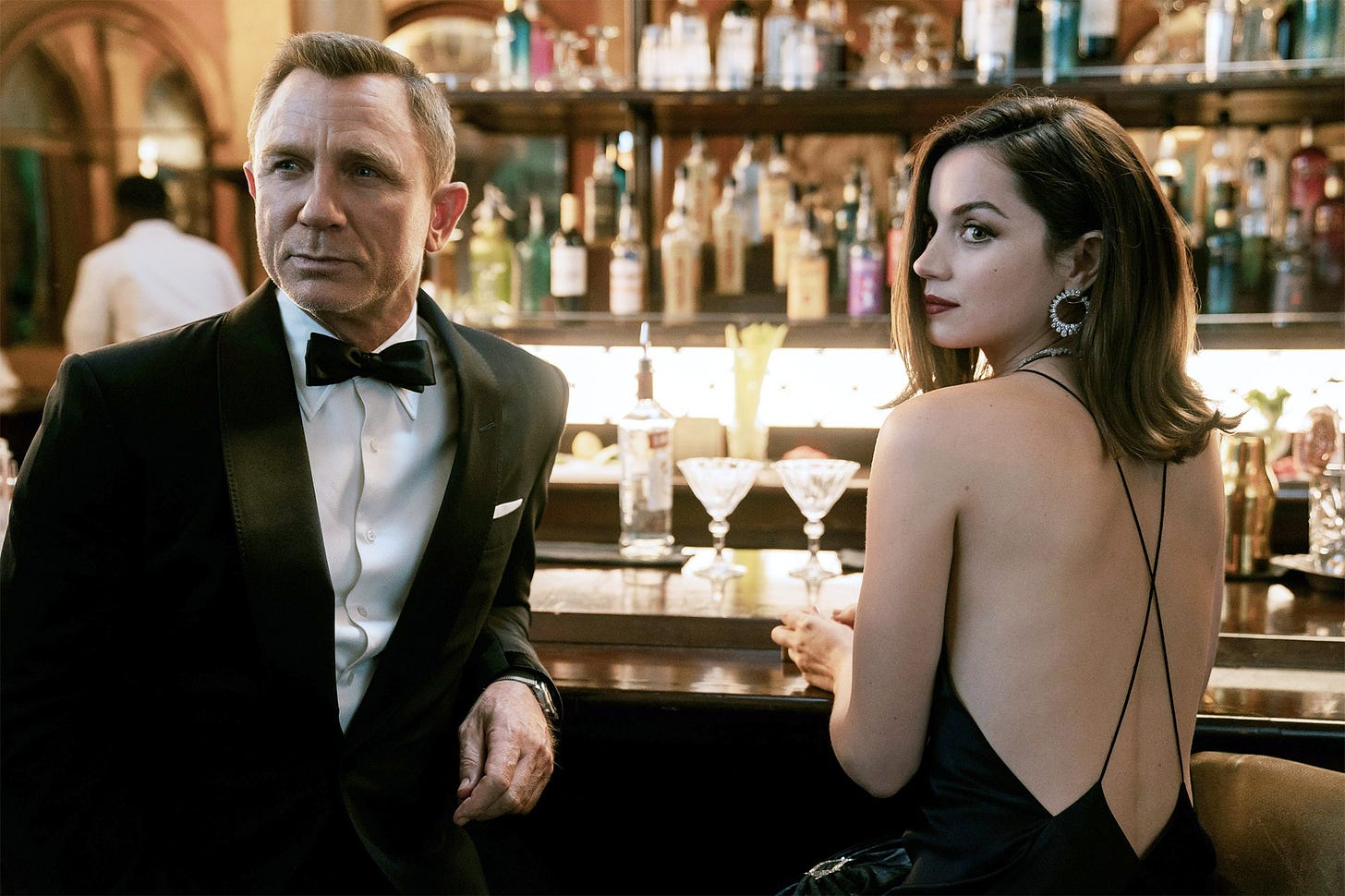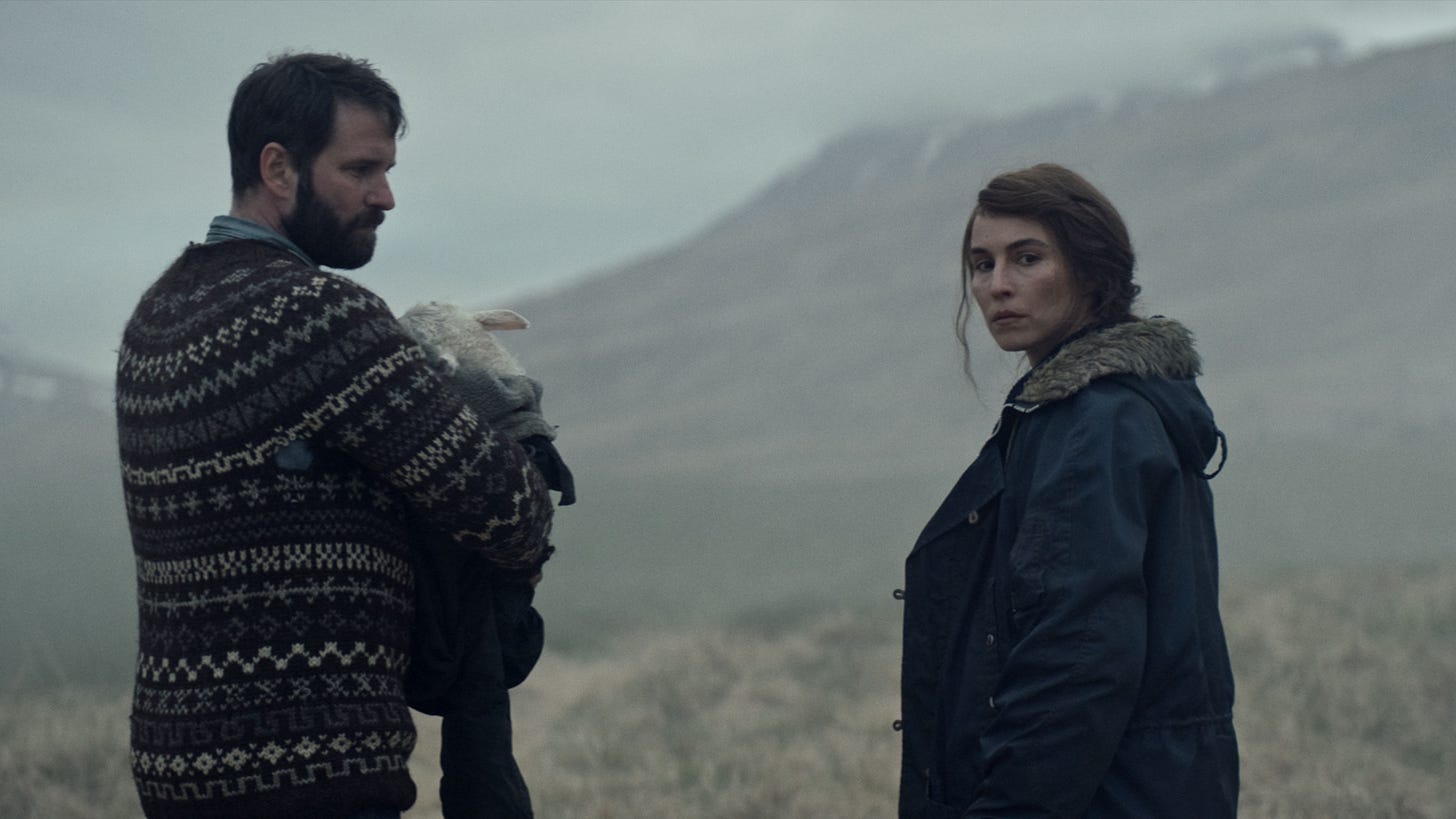In Review: 'No Time to Die' and 'Lamb'
The James Bond series brings the Daniel Craig era to a close. Meanwhile, in Iceland, a grieving couple forms an unconventional family.
No Time to Die
Dir. Cary Joji Fukunaga
163 min.
Viewers could be forgiven for wondering if they wandered into the wrong movie during the opening moments of No Time to Die, the much-delayed 25th entry in Eon Productions’s James Bond series. Not only is Bond nowhere in sight, the sequence seems to belong to a different sort of film altogether, a home-invasion thriller set at a luxurious, isolated lakeside estate, pitting a seemingly helpless girl against a masked killer during the chilliest stretches of a Scandinavian winter. Tensely staged by director Cary Joji Fukunaga (Beasts of No Nation, True Detective), it’s filled with eerie, unsettling choices, from the blank expression of the killer’s mask to the use of opaque glass to create brief but striking moments of near total abstraction. It plays like a brief but satisfying mini-movie that knows exactly what it wants to be. The film that follows, on the other hand, has trouble making up its mind.
That’s not always to its detriment. The new Bond — a swan song for star Daniel Craig who took over the role in the long-ago year of 2006 — plays a bit like a sample platter of elements from throughout Bond history, particularly the films of the Craig era: intense moments of two-fisted action drawn from Casino Royale and Quantum of Solace, the mix of sleek action and aggressively beautiful imagery of Skyfall and Spectre, and, in the end a grotesque supervillain (Rami Malek, going big behind a face full of scars) with a sophisticated lair and a world-endangering plot. The lattermost have been Bond staples since Sean Connery first took on Dr. No, but the Craig-era Bonds, favoring a more grounded approach, have struggled to incorporate them. (Quantum of Solace, for instance, made do with a luxury hotel and a scheme to corner the Bolivian water market.) No Time to Die introduces them so slowly and slyly it’s hard to pinpoint the moment when the film crosses back into classic Bond terrain.
The Reveal is a reader-supported newsletter dedicated to bringing you great essays, reviews and conversation about movies (and a little TV). While both free and paid subscriptions are available, please consider a paid subscription to support our long-term sustainability.
No Time to Die also takes the scenic route as it attempts to tie up ends left loose by all four preceding Craig movies. Most immediately, that means picking up where Spectre left off, with Bond and Madeleine Swann (Lea Seydoux), a psychiatrist whose family history is uncomfortably entwined with the villainous secret organization that gave Spectre its name, attempting to leave espionage and danger behind them. That’s not so simple. It’s the young Swann, we quickly learn, matching wits with the masked killer in the opening moments, and it will turn out, in the film’s present, that he’s not done with her yet. And though Bond and Swann seem happy and hopeful as they cruise Europe in Bond’s famous Aston Martin, one line of dialogue suggests their bliss won’t last: “We have all the time in the world.”
It’s a cursed phrase for Bond movies, one first uttered in 1969’s On Her Majesty’s Secret Service, a film that concludes with Bond marrying a woman who’s in many ways his match — Tracy Draco, played by Diana Rigg — only to end the film in mourning when she’s gunned down in the still-shocking final moments. It also serves as a reminder that the series killed off Tracy’s modern equivalent, Vesper Lynd (Eva Green), in Casino Royale, Craig’s first installment. Lynd’s death has hung over the subsequent Bonds, both as a plot point to explain the intense weariness that’s served as 007’s defining trait in the Craig era but also as a romantic pairing none of its sequels have found a way to match. As in Spectre, Craig and Seydoux both deliver fine individual performances, but together they generate more sparks than heat no matter how much their characters talk about being in love.
That’s occasionally a problem in a film in which this is the bond that drives the plot, but it rarely gets in the way of Fukunaga easing from one striking action scene to the next. The best arrives relatively early. Though seemingly committed to remaining retired in a tropical paradise, Bond’s called back into action by his close friend, CIA Agent Felix Leiter (Jeffrey Wright), who enlists Bond’s aid on a mission to Cuba. This quickly becomes a classic tuxedo-and-martinis-and-Walther PPK outing during which Bond finds himself paired with Paloma (Ana de Armas), a green, apparently ill-prepared CIA agent wearing a dress seemingly designed to distract any enemies. Though her appearance is fleeting, de Armas is so winning in the film’s lightest, loosest stretch that Paloma practically demands a spin-off.
Or maybe give one to Nomi (Lashana Lynch), the MI6 agent who’s assumed Bond’s 007 designation in the time since his retirement (and whose name seems to be an homage to Showgirls). Lynch exudes the sort of capability and calculation of Bond in his prime, and Nomi’s ascent is one of the film’s many suggestions that the era that made a hero of Bond — still fundamentally a man eager to solve problems with violence, quick to abandon (at least some of) the women he beds, and capable of waving it all away with a one-liner — might be ending, despite the continued persistence of the system that supports and relies on hi, populated by familiar faces like M (Ralph Fiennes), Q (Ben Whishaw), and Moneypenny (Naomie Harris). But not quite yet. Though his run has had its ups and downs — up to and including No Time to Die, which has been announced as his final outing — Craig delivers some of his best work as Bond here. He’s convincingly, sometimes frighteningly tough but also, when the plot requires it, surprisingly tender.
The specific reason he’s required to be tender, however, should remain undiscussed until everyone has had a look at the movie, at which point it will likely be all anyone talks about. (Spoiler-averse, please try to read as little as possible about No Time to Die before seeing it, apart from this review, of course.) But while No Time to Die sometimes labors to make connections to the Craig movies that have come before, the conceptually bold finale makes the effort feel worthwhile. After a sprawling, mostly solid globe-trotting Bond adventure that veers from breathtaking chase sequences to brutal fisticuffs, Fukunaga and the screenwriting team of Neal Purvis, Robert Wade, and Phoebe Waller-Bridge pull back, get big picture, and ask viewers to consider what it means that we're still fascinated by this sophisticated, murderous super spy on whose shoulders we’ve placed the fate of the world so many times, and why we still welcome his return in a world that that’s evolving faster than he can keep up.
Lamb
Dir. Valdimar Jóhannsson
110 min.
Lamb, the first feature film from Valdimar Jóhannsson, is set in the rural isolation of the Icelandic countryside, but it really takes place in an indeterminate space where the lines between humans and animals, joy and grief, and the past and present have become dangerously blurry. It’s home to Maria (Noomi Rapace, whose executive producer credit on the film rests next to that of Hungarian arthouse legend Béla Tarr) and Ingvar (Hilmir Snær Guðnason), a married couple who go about the business of tending their farm and minding their herd of sheep with a sense of bittersweet resignation, Their love for one another serves as a bulwark against the sadness that might otherwise overwhelm them, one always at the edges of even a casual breakfast conversations about theoretical breakthroughs in the physics of time travel. The source of that sadness, the film reveals after a bit of hesitation, is the loss of their daughter Ada. It’s even slower in unveiling other elements of their life together.
A bit later, while watching television, Maria turns to Ingvar to confirm a line of dialogue she missed. He missed it, too, replying only, “Something about folk tales, I think.” It’s the closest Lamb — which skirts the borders of horror and wry dark comedy — comes to clarifying what sort of film its audience is watching. Shortly after, Maria gets up to close the window and mute the sound that’s making the television hard to hear: the baleful bleating of a single sheep who has reason to be upset with the couple: Maria and Ingvar have added a third member to their family, a lamb they’ve taken to calling Ada and treating like a child.
There’s more to the story, but to reveal it would be to spoil a later image that’s as unsettling as it is beautiful. Co-written by Jóhannsson and Sjón — the author, poet, playwright, Björk collaborator, who also co-wrote Robert Eggers’s forthcoming The Northman — Lamb plays like an adaptation of a passed-down story whose origins and meaning have gotten obscured over time but whose vagueness makes it more resonant. Jóhannsson’s disciplined direction, understated performances from Rapace and Guðnason (and Ada), and the dramatic contrasts of the Icelandic countryside — where mist-covered hills roll out from the base of imposing mountains — combine to set a tone of verdant unease. The family risks disaster as they try to sustain the happiness they’ve found together. The arrival of Ingvar’s brother Pétur (Björn Hlynur Haraldsson), who’s shaken and initially disgusted by their new family arrangement, serves as a sobering reminder that the couple has transgressed against the natural order and the probability that this in-between space they’ve carved out will collapse, likely taking them with it. Some desires, the film suggests, can’t be fought no matter what consequences they invite.








I'm looking forward to talking these movies over with people after they've seen them. There's much to spoil in each and I tiptoed around that. But maybe signal you've got a spoiler in your comment when you post.
Lamb look fascinating, and me would like to see it at some point, but at risk of losing indie cred, me more excited to finally see Bond than anything else coming out this year. So me relieved to see good review here. Craig has been so good in role, but even apart from that, writing (Spectre excepted) and direction really took step up from previous Bonds. And me appreciate approach series this long-in-tooth take, of deconstructing Bond mythos and then reconstructing Bond into more complex character.